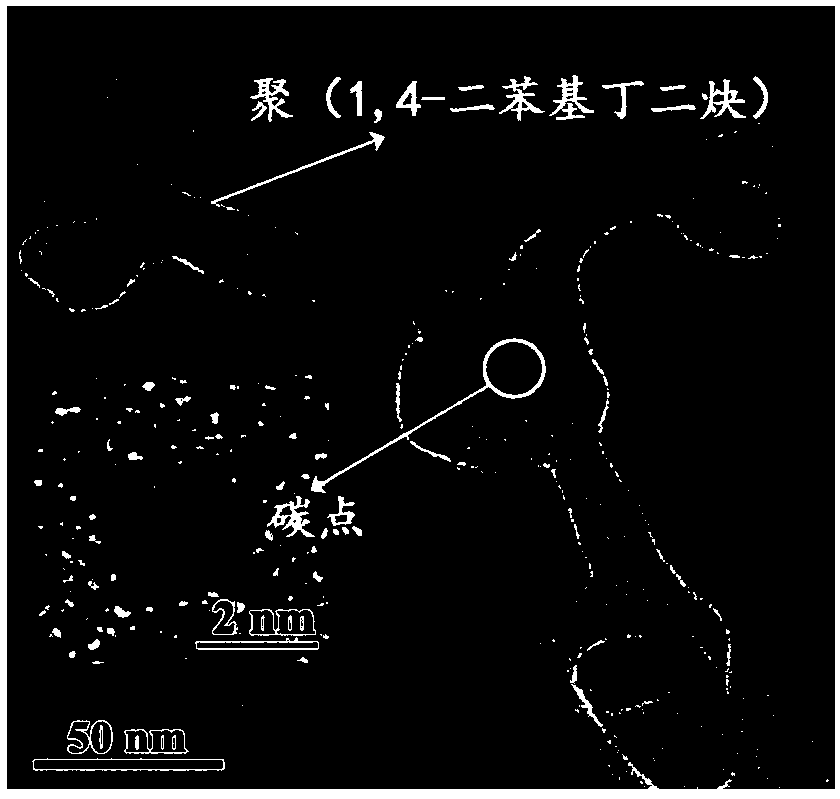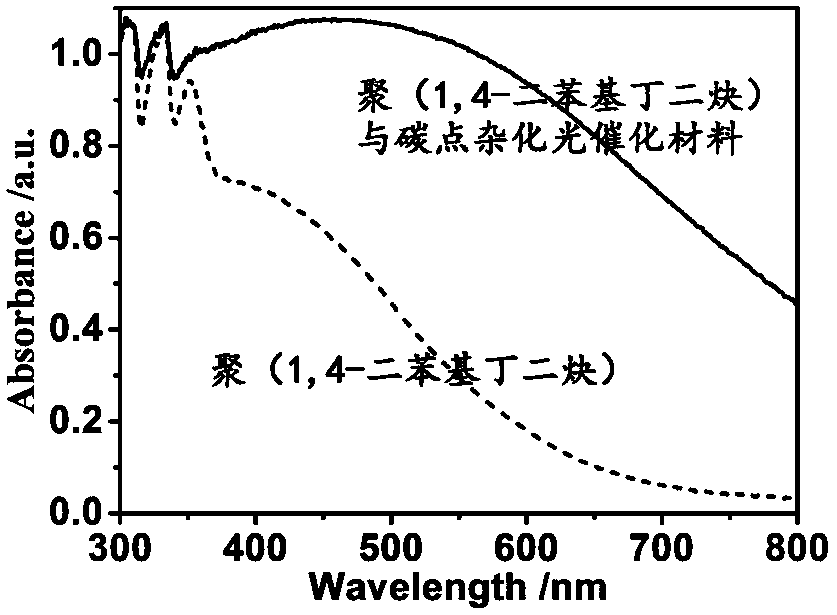One-step synthesis of carbon dots/poly-1,4-diphenylbutadiyne hybrid photocatalytic materials
A technology of diphenylbutadiyne and photocatalytic materials, applied in the field of nanomaterials, can solve the problem of difficulty in mass production of poly-1,4-diphenylbutadiyne, achieve excellent visible light absorption capacity, and is beneficial to industrial large-scale production. The effect of large-scale production, excellent photocatalytic performance
- Summary
- Abstract
- Description
- Claims
- Application Information
AI Technical Summary
Problems solved by technology
Method used
Image
Examples
Embodiment 1
[0022] A method for synthesizing carbon dots / poly-1,4-diphenylbutadiyne hybrid photocatalytic material in one step, adopts the following steps:
[0023] (1) Take 1 gram of 1,4-diphenylbutadiyne solid powder and evenly disperse it to the bottom of a 25 ml hydrothermal reaction kettle with a thickness of 3mm;
[0024] (2) Put the lined tank filled with 1,4-diphenylbutadiyne solid powder into the steel tank and then vacuumize it so that the internal pressure is less than 0.1 atmosphere, and then fill it with a mixed gas of oxygen and nitrogen to 1 Atmospheric pressure, finally sealed, wherein the volume ratio of oxygen to nitrogen is 2;
[0025] (3) Put the sealed reaction kettle into a blast oven, keep it warm at 95°C for 50 minutes, and then cool it to room temperature to obtain a hybrid photocatalyst of conductive poly-1,4-diphenylbutadiyne and carbon dots Material.
[0026] The performance test and characterization of the synthesized carbon dots / poly-1,4-diphenylbutadiene h...
Embodiment 2
[0028] A method for synthesizing carbon dots / poly-1,4-diphenylbutadiyne hybrid photocatalytic material in one step, adopts the following steps:
[0029] (1) Take 1.5 grams of 1,4-diphenylbutadiyne solid powder, and evenly disperse it to the bottom of the lined tank of the hydrothermal reaction kettle with a thickness of 5mm;
[0030] (2) Put the lined tank filled with 1,4-diphenylbutadiyne solid powder into the steel tank and then vacuumize it so that the internal pressure is less than 0.1 atmosphere, and then fill it with a mixed gas of oxygen and nitrogen to 1 Atmospheric pressure, finally sealed, wherein the volume ratio of oxygen to nitrogen is 3;
[0031] (3) Put the sealed reactor into a blast oven, keep it warm at 135°C for 150 minutes, and then cool it to room temperature to obtain a hybrid photocatalyst of conductive poly-1,4-diphenylbutadiyne and carbon dots Material.
Embodiment 3
[0033] A method for synthesizing carbon dots / poly-1,4-diphenylbutadiyne hybrid photocatalytic material in one step, adopts the following steps:
[0034] (1) Take 2 grams of 1,4-diphenylbutadiyne solid powder, and evenly disperse it to the bottom of the lined tank of the hydrothermal reaction kettle with a thickness of 7mm;
[0035] (2) Put the lined tank filled with 1,4-diphenylbutadiyne solid powder into the steel tank and then vacuumize it so that the internal pressure is less than 0.1 atmosphere, and then fill it with a mixed gas of oxygen and nitrogen to 1 Atmospheric pressure, finally sealed, wherein the volume ratio of oxygen to nitrogen is 2;
[0036] (3) Put the sealed reactor into a blast oven, keep it warm at 120°C for 100 minutes, and then cool it to room temperature to obtain a hybrid photocatalyst of conductive poly-1,4-diphenylbutadiyne and carbon dots Material.
PUM
 Login to View More
Login to View More Abstract
Description
Claims
Application Information
 Login to View More
Login to View More - R&D
- Intellectual Property
- Life Sciences
- Materials
- Tech Scout
- Unparalleled Data Quality
- Higher Quality Content
- 60% Fewer Hallucinations
Browse by: Latest US Patents, China's latest patents, Technical Efficacy Thesaurus, Application Domain, Technology Topic, Popular Technical Reports.
© 2025 PatSnap. All rights reserved.Legal|Privacy policy|Modern Slavery Act Transparency Statement|Sitemap|About US| Contact US: help@patsnap.com



